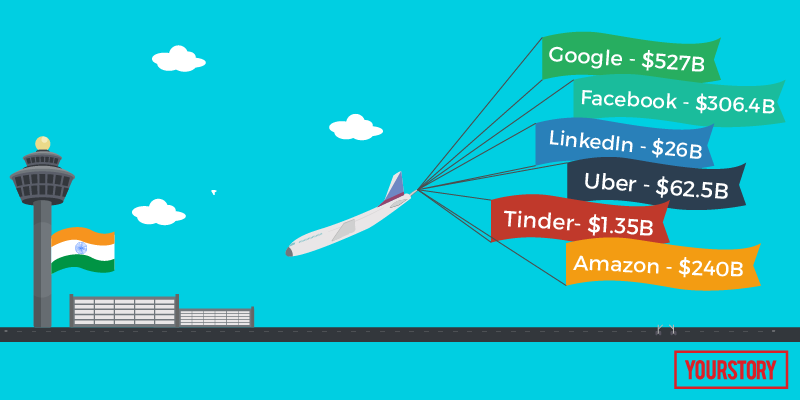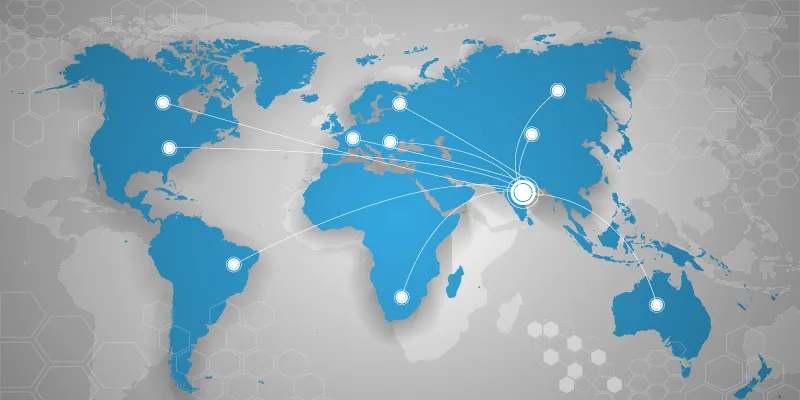How global technology businesses are breaking into the India market
Athira Nair

Wednesday June 29, 2016 , 8 min Read
With a huge population, growing middle class and deeper smartphone penetration, India is possibly one of the biggest markets for world businesses running on technology. This is indicative by Jeff Bezos, Founder of Amazon, pumping in $3 billion into India earlier this month. Tim Cook, CEO of Apple, came to India as well, seeing that it is the third largest smartphone market, with a reported sale of over 100 million handsets last year.

The great middle class
While the Indian consumer market can be broadly divided into urban and rural, it also comprises of a massive middle class, believed to be a relatively affluent class with spending anticipated to more than double by 2025.
A McKinsey study suggests that if India grows at its current pace, the average household incomes will triple, making the country the world’s fifth largest consumer economy by 2025. Another report by CII and BCG state that the Indian consumer spends is likely to touch $3.6 trillion by 2025 and India’s share of global consumption would touch close to 5.8 percent by 2020.
Shivakumar, CEO of Pepsico India, adds that close to 600 million people will be on the Internet by 2020. This means that by 2020 there will be significant change in consumer behaviour. He adds that e-commerce today is roughly a $16-billion market; by 2020, this number will be close to $80-100 billion.
“The FMCG industry is currently a $40-billion market; by 2020, it will be worth $65 billion. This means in a matter of five years, e-commerce will be bigger than the 100-year-old FMCG industry,” adds Shivakumar.
Looking at the growth of the middle class and the growth in their income per annum, Shivakumar adds that these households will be truly global citizens, demanding the best in design, performance and technology.
Sanjay Anandaram, Venture Partner Seed Fund, Advisor iSpirt and Ojas Ventures believes that businesses go where money attracts them. He adds that opportunity is phenomenal and that is what drives people to India.
The market ‘breakers’
It is also important to recruit people who have experience in the Indian market – those who have built businesses, ran operations, and can handle issues with administration, bureaucracy and the law in the country, in addition to customers.
The first recruits into a new market for Uber are the ‘launchers’ who go into a market for research and get the city started; essentially they are first feet on the ground. Launchers get the city up and running and wear multiple hats - marketing, operations, recruiting, support) in the early stage of cities.

Varun Mundkar, Launcher, Uber India, explains how they break into the market: “We look out for marketing managers and operations managers to drive the demand and supply side of the business. The launchers ultimately transition over to 'general managers' who are responsible for both driver and rider side of operations, and to grow the city in the long term.”
It happens only in India
“The foreign companies coming to India need to understand the bureaucracy and regulatory issues. Then the Indian consumer is not just a homogeneous mass. Each State is different in language, food, and behaviour. Cultural icons and motifs are different. Anything that affects the cultural behaviour is an issue too,” says Sanjay.
When McDonald's entered India in 1996, the company had faced several problems. It then went through a complete localisation strategy. McDonald's changed its product menu to accommodate the vegetable burger given the large vegetarian population. It also altered its store design and even reduced the product price by close to 15 percent.
Similarly, Uber started cash payments in India. They have not done that elsewhere. “'Think global, act local' is their mantra. That’s true of any business getting into the market,” says Sanjay. Varun adds that Uber allowing cash payments stemmed from the company realising that practice of payments through digital wallets, credit or debit cards are still at a nascent stage in India, with cash being the primary and preferred mode of payment.
With the feedback they received on the launch of cash payments, Uber has taken it to a few other developing countries. The thumb rule Uber follows is relevance in the markets it operates in. “We hire people who know the city they work in, and are passionate in helping improve the way people get around in those cities,” says Varun.

LinkedIn was used by people in India for a long time before they decided to set up a team here, primarily to drive marketing and recruitment initiatives. And yet for India, its second largest market, the company has accommodated ‘local flavours.’ Akshay Kothari, Country Manager and Product Lead, LinkedIn India, says that for the India market they will specifically focus on the Android app, and make the platform work even with low connectivity issues.
“We believe a little localisation for the India market, like pricing change, language and speed, will help break into the market,” says Akshay.
The game of numbers
India is massive market, and the sheer size, followed by rapid increase in buying power and penetration of technology, makes it difficult to compare it with other developing economies.
For Uber, India was the third largest market, after the US and China. Based purely on the market size, over time, the company believes it would be possible for India to surpass the others. Uber initially started only with UberBLACK cars and soon launched uberX, their lower priced sedan model. This was followed by the launch of UberGO, their most affordable transportation option with hatchbacks.
“We have always focussed on launching products that are not only country-specific but also city-specific and those that cater to the needs of the mass market. Uber has constantly evolved its offerings to make them relevant to the cities we operate in over the years with products like cash payments, uberAUTO being global-firsts for us,” explains Varun.
It is all about the technology
It just isn’t Silicon Valley-founded tech businesses that are looking at India; China has already made several moves in India, and has invested in Paytm and Snapdeal. Also with Alibaba looking for a major team in India, it can be safely assumed that the company will soon launch online retail operations in India.
Anuj Roy, Senior Partner Transearch Consultants, says that there are two types of companies currently eyeing the Indian market. One, are those that want to establish in India and run the India business, and then there are companies with back-up office in India for product and operations. “Facebook and Uber came in both categories. Uber first set up office in India by outsourcing,” he adds.

Technology, product, and operations have been historically the major reasons for the top companies to come to India. For Google, a bulk of their operations is run out of Hyderabad. Amazon has their operations, customer service, and technology run out of Hyderabad. Smaller companies, which set up shop here, are mostly tech or product companies.
Smaller companies are looking for cost arbitrage as well as talent availability. Multiple dimensions like ease-of-doing business, for instance, the local government willing to incentivise setting up a new business, will influence a company in choosing a particular city to pilot in.
Citing an example, Anuj adds that Swedish company Saltside Technologies, a horizontal classifieds company like OLX, set up shop in India – in Bengaluru last year – by hiring ex-eBay Salim Imani as their CTO, and building their technology around that.
Their challenges will depend on their requirements. For scaling, geography and the right kind of talent matters. For instance, Saltside hired someone with such a huge compensation that it could have helped them get someone from local geography anywhere.
Tackling the dragon
“Most of these guys have given up or had a tough time in their attempt to break into China. The next best opportunity outside of China is India,” Sanjay says. India has one up on China, as far as freedom of conducting business goes. The language, cost structure and workforce availability are the biggest differentiators that favours India against China.
While there are several Indian counterparts, like Ola for Uber, Flipkart for Amazon, dating sites like Woo for Tinder, Stayzilla and OYO for Airbnb, the global counterparts end up giving the Indian companies stiff competition. In contrast, the Chinese government gives preference to Chinese companies and the local companies are good and competitive. The Indian government, however, has several open-door policies like 100-percent FDI.
Companies like LinkedIn, Snapchat and WhatsApp, Anuj believes, don’t need to be physically present in a market to run a business there. He says that such platforms get built on their own. Even for Facebook, their India business team came in quite late, as for with Google.
They come to India for sales, while their teams help them monetise the business. Plans to set up a physical office happens only when there are grand plans for monetisation. Otherwise it’s only about outsourcing. “For their core product – people will use it in India anyway,” says Anuj.
India has grown from being the low-cost backend operations’ yard to the business arena where more foreign players come for business and monetisation. Coming years will this trend growing, as India is slowly but steadily getting ahead in the race of developing economies. While the European and Middle Eastern markets are down, India could be the next China soon.






